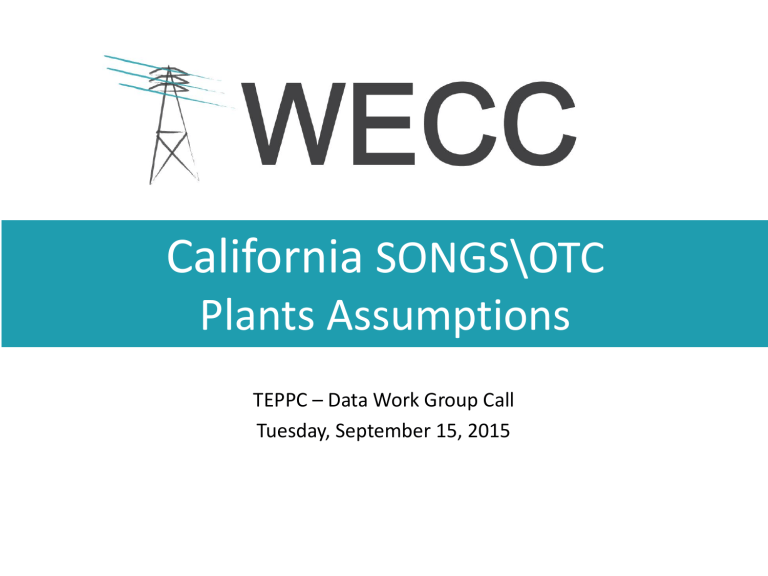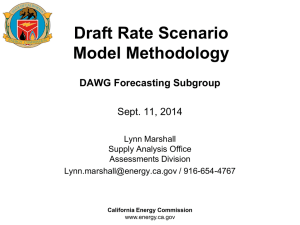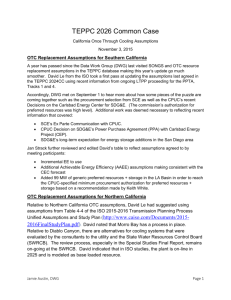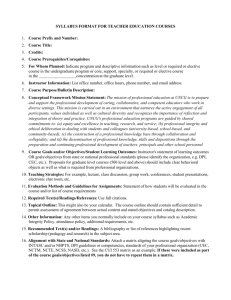Data Work Group Meeting: SONGS

California
SONGS\OTC
Plants Assumptions
TEPPC – Data Work Group Call
Tuesday, September 15, 2015
Overview
• Status of OTC Replacement Assumptions For the TEPPC
2026 Common Case
– CEC Demand Forecast
– CEC Demand Response
– CAISO\CEC
• Monthly Peak/Energy Load?
• AAEE assumptions? Embedded in monthly load or separate?
• Other EE assumptions? Embedded in monthly load or separate?
• BTM DG assumptions? Embedded in monthly load or separate?
• DR assumptions? Embedded in monthly load or separate?
– Additional Generic Preferred Resources in the LA Basin
– OTC Replacement Assumptions for Northern California
– Final OTC Plant Assumptions Table
2
Status
• Southern California
– Meeting participants generally agreed to a detailed spreadsheet showing substation-level detail for CPUC-authorized Once-Thru-
Cooling (OTC) replacement procurement assumptions.
– However, Few questions were raised about levels of Energy
Efficiency and Demand Response forecasts and recommended treatment in TEPPC modeling.
• Northern California
– Just use assumptions in the CAISO 2015-2016 Study Plan, listed in Table 4-4. Exception, use the CEC assumptions for Moss
Landing units 1&2.
( http://www.caiso.com/Documents/2015-2016FinalStudyPlan.pdf
)
3
Table 4-4: Once-through cooled generation in the California ISO BAA
4
CEC Demand Forecast
Angela Tanghetti
California Energy Commission
5
CEC Demand Forecast
– 10 year forecasts of electricity consumption and peak demand
– CED 2013 and 2014 Updated included 8 major utility planning area in California, and 16 climates zones
– CED 2015 uses a modified planning area scheme more closely matched to the states balancing authority areas
P A G E 6
Energy Efficiency and CEC’s Demand
Forecast
• Energy Efficiency – CEC demand forecasts seek to account for efficiency and conservation
reasonably expected to occur. Reasonably expected to occur initiatives have been split into two types: committed and additional achievable energy efficiency
• The CED 2015 Preliminary baseline forecasts continue that distinction, with only committed efficiency included
P A G E 7
Energy Efficiency and CEC’s Demand
Forecast
• Committed includes utility and public agency programs, codes and standards, and legislation and ordinances having final authorization, firm funding
• A demand forecast for resource planning requires a baseline forecast combined with additional achievable energy efficiency savings
(not yet considered committed but deemed likely to occur)
P A G E 8
BTM PV Peak and Energy Impact On CEC
Demand Forecast
• For CED 2015 Preliminary, staff spent time refining the peak factors used to translate PV installed capacity to impact during the utility annual peak hour.
• To refine PV peak factors staff examined simulated PV production profiles provided by
CPUC relative to utility annual peak day between 2011 through 2014.
P A G E 9
PV Peak Factors
Utility CED 2011 CED 2013 CED 2015
PG&E 55% 50% 37%
SCE 62% 50% 40%
SDG&E 68% 50% 40%
Source: California Energy Commission, Demand
Analysis Office, 2015
P A G E 1 0
CED 2015 Mid Case BTM PV
Statewide
2026
Mid_Demand
Installed Capacity Peak Capacity Energy
MW
13,194
MW
5,062
GWh
23,450
Capacity Factor
%
20.3%
If BTM PV is modeled as supply side resource installed capacity in addition to peak impact and energy is required. Hourly profile must have similar capacity factor
P A G E 1 1
CEC Demand Response
Lana Wong
California Energy Commission
12
Demand Response
• Demand-side DR – embedded in CEC Demand forecast
– Non-event based, critical peak pricing and peak time rebates
– Non-dispatchable
– Customer controlled
– Draft June 2015 Demand report, 261 MW by 2026:
• PG&E 125 MW
• SCE 90 MW
• SDG&E 46 MW
Demand Response (cont.)
• Supply-Side DR – not embedded in CEC
Demand forecast
– Dispatchable
– Event based and price responsive
– Counts for Resource Adequacy - include in planning reserve margin calculations
– CPUC LTTP Planning Assumptions based on
Utilities’ Load Impact Reports
Demand Response (cont.)
– Dispatchable DR (MW) - CPUC Scenario Tool 2014 for
2026
• PGE Bay – 139 MW
• PGE Valley – 634 MW
• SCE – 1,361 MW
• SDGE – 42 MW
Note: above values include avoided T&D losses;
Load Impact Reports of each IOU (Portfolio-adjusted ex-ante estimates for August in a 1-in-2 weather year, generally average load impact over the hours of the day an event may be called)
– Different quantities of DR are modeled depending on the type of study
CPUC-Authorized OTC Replacement Procurement
Assumptions for TEPPC 2026 Common Case
Jan Strack
Sempra Energy Utilities
16
17
CPUC-Authorized OTC Replacement Procurement
Assumptions for TEPPC 2026 Common Case
• Substation-level detail for CPUC-authorized Once-Thru-
Cooling (OTC) replacement procurement assumptions for incorporation into the TEPPC 2026 Common Case.
• added 99 (100) MW of generic preferred resources + storage in the LA Basin in order to reach the CPUC-specified minimum procurement authorization for preferred resources + storage. specific types as suggested by the
CPUC staff.
• It is assumed that the EE numbers included in this workbook are incremental to the Additional Achievable
Energy Efficiency (AAEE) forecast developed by the CEC.
Likewise, the behind-the-load meter solar PV numbers would be in addition to the amounts forecast by the CEC.
18
Additional 100 MW of Preferred in the LA Basin
• The 25 MW of generic Behind-The-load-Meter (BTM) solar PV
(column G) would be modeled with the same shape as the 37.92
MW of BTM solar PV (column E).
• The 25 MW of generic storage (column P) would be modeled with the same performance characteristics as the 100 MW (column L) of 4 hour In-Front-Of-the-load Meter (IFOM) storage.
• The 25 MW of generic incremental Energy Efficiency (EE) (column
U) would be modeled with the same shape as the 124.21 MW of incremental EE (column S).
• The 25 MW of generic demand response (column Z) would be modeled with the same performance characteristics as the 75.05
MW (column X) of ISO market-implemented demand response.
19







